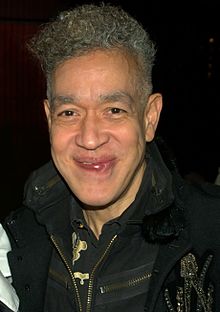Andres Serrano

Andres Serrano (born August 15, 1950 in New York City ) is an American photo artist, in whose work religion and sexuality play an important role. He was best known for the use of body fluids such as blood, urine and semen in his works as well as his photographs of corpses (" The Morgue ", 1992).
Life
Serrano is the son of a Honduran immigrant and a mother of Afro-Cuban origin. He grew up in Williamsburg (Brooklyn) in a strictly Catholic milieu due to the Italian-American neighbors . He studied at the Brooklyn Museum of Art School from 1967 to 1969 . Before his career as a photo artist, he was a painter and sculptor. Serrano lives and works in New York.
His work has been shown in many and prestigious locations such as the Episcopal Cathedral of Saint John the Divine in New York and the Barbican Center in London . Andres Serrano was elected a full member ( NA ) of the National Academy of Design in New York in 2015 .
Works
One of his most famous and at the same time most controversial photographs is “ Piss Christ ” (1987), which shows a crucifix in a plexiglass vessel filled with urine. Further photographs in this photo series show classic statuettes that are covered in various liquids such as milk, blood and urine.
The Morgue
For his photo series "The Morgue", which consists of fifty pictures, Serrano went to a morgue to take photos of the deceased. He did this with the knowledge and consent of a forensic doctor, but not the relatives or the deceased themselves. That is why the corpses are portrayed or covered in such a way or the image detail is always chosen so small that their identity cannot be recognized. The titles of the pictures do not reveal the name either, only the cause of death. The focus of his camera is often on details, eyes, ears, mouth and wounds, but also hands and feet. Black fabric was used as the background.
Except for placing towels, Serrano did not arrange the bodies, but left them as he found them. Nevertheless, the photographs differ significantly from the purely forensic pathology photography, which is clinical and distant and only represents a purely technical representation. Serrano's pictures, on the other hand, appear much more personal, more subjective and show an artistic perspective. Neither the use of violence nor its traces, such as wounds and blood, nor the side effects of death remain hidden in the photographs. Serrano does not want to show the intact, beautiful dead person, his intention was not to shock, but to give the viewer a look behind the scenes, behind which everyone can find himself again.
Serrano's artistic photographs of corpses differ significantly from the historical photography of the dead, which took place in one's own home or in the laying out room and served to remember the deceased. Much more, other intentions are being pursued here, such as dealing with death itself.
Cover Art
Serrano is responsible for the covers of the two Metallica albums Load and ReLoad . For the former he used his ejaculate and bovine blood, which he pressed under a glass plate. For the second work he used urine and again bovine blood. The works are named "Blood and Semen III" and "Blood and Urine".
literature
- Andres Serrano in interviews with Anna Blume. In: Sussler, Betsy (ed.): Speak art! The best of BOMB magazine's interviews with artists . New York 1997, pp. 203-209.
- Andres Serrano, Idosyncratic Iconography. In: Anette W. Balkema & Henk Slager (eds.): The Photographic Paradigm . Amsterdam / Atlanta 1997. pp. 106-110.
- Jens Guthmann: Looking Death in the Face - Images from the Morgue in Contemporary Photography . Lecture at the 8th annual conference of the European Dance of Death Association from April 26th to 28th, 2002 in the Medical History Institute and Museum of the University of Zurich.
- I. King: The "objective" dead. Corpse photography as a mirror of how the dead are dealt with . Diplomica Verlag 2008, Hamburg, ISBN 3-83666-435-6
- Peter W. Williams: Perspectives on American religion and culture , Malden (1999), Wiley-Blackwell.
Web links
- Andres Serrano on kunstaspekte.de
- Photo gallery (note: corpses can be seen in the photos)
- Interview with Andres Serrano from Bomb Magazine No. 43, 1993 ( Memento from March 21, 2013 in the Internet Archive )
Individual evidence
- ↑ Ina König: The "objective" dead. Corpse photography as a mirror of how the dead are dealt with , Hamburg 2008, p. 92.
- ^ Andres Serrano, American (1950 -) , artist biography, rogallery. com
- ↑ nationalacademy.org: Academicians Elected in 2015 ( Memento of August 23, 2016 in the Internet Archive ) (accessed November 21, 2015)
- ↑ Andres Serrano, Idosyncratic Iconography. In: Anette W. Balkema & Henk Slager (eds.): The Photographic Paradigm . Amsterdam / Atlanta 1997. pp. 106-110.
- ↑ Peter W. Williams: Perspectives on American religion and culture , Malden 1999, p. 400.
- ↑ Ina König: The "objective" dead. Corpse photography as a mirror of dealing with the dead , Hamburg 2008, pp. 92–95.
- ↑ Andres Serrano in interviews with Anna Blume. In: Betsy Sussler (ed.): Speak art! The best of BOMB magazine's interviews with artists . New York 1997, pp. 203-209.
- ↑ Jens Guthmann: Seeing Death in the Face - Images from the Morgue in Contemporary Photography . Lecture at the 8th annual conference of the European Dance of Death Association from April 26th to 28th, 2002 in the Medical History Institute and Museum of the University of Zurich.
- ↑ http://www.jensguthmann.de/zuerich.pdf
| personal data | |
|---|---|
| SURNAME | Serrano, Andres |
| BRIEF DESCRIPTION | American photographer and artist |
| DATE OF BIRTH | 15th August 1950 |
| PLACE OF BIRTH | New York City |

